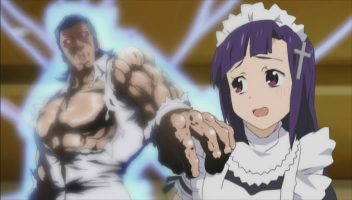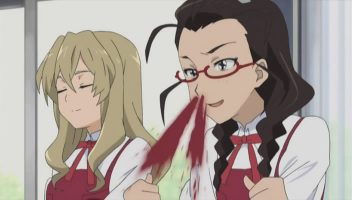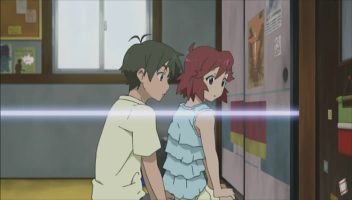Kannagi — Final Thoughts
Kannagi was a series that I saw people blogging about and indeed had seen some promo images for it. However, despite the cute character designs and “Crazy Shrine Maidens” English subtitle (which has some people scratching their heads since only the Kannagi character wears a miko costume) and the possible mahou shoujo element, I really can’t say my head was turned. After all, my backlog of anime is quite extensive and I need to catch up. However when MS and some others suggested that I would in fact enjoy this title based on my previous likes and dislikes, I decided to take a chance and start watching this anime. Boy, am I glad I did!
The series starts of by only introducing us to the main characters of Nagi and Jin, then works in Tsugumi before introducing us to the rest of the cast. For the first ten episodes, the focus is mainly on the humor with some plot elements tossed in from time to time. The characters have some excellent seiyuu work done for them, which makes things all the more enjoyable. TOMATSU Haruka should be noted for really making the character of Nagi just a complete pleasure and hoot. The casting of her in this role is just brilliant. I highly doubt an American VA could even come close to matching the variances in performance, both in terms of accent and emotion.
The supporting cast is very good too. There’s Jin’s big dumb friend and art club member Daitetsu, Jin’s “I’m not an otaku” otaku friend and art club member Akiba, art club president and semi-otaku Takako, soft spoken art club vice president Shino (who somehow comes across as very interesting — maybe its because she never opens her eyes), and Nagi’s kami-sister Zange-chan (in the body of student Hakua, which is a plot element I’d like to see explored further). Zange-chan comes off as almost evil at first, but for whatever reason, that aspect is quickly dropped and to be honest, I am glad it was. After all, Zange-chan provided for some good laughs.
Director YAMAMOTO Yutaka deserves a great deal of credit too. He clearly has a great understanding of comedic timing and what it takes to make things funny. I’ve always maintained that doing the unexpected for comedy works best. Even if you are doing a joke that is old (such as the food jokes that often come up in anime), if you do unexpected things or make people wait for the expected payoff so that they don’t know exactly when it will hit, then you have the makings of a very funny series. That’s exactly what Yamamoto-san does — he will do the unexpected, but also perform the comedic timing to such a degree that more often than not, he achieves maximum laughs.
Also, the production team shows that they clearly understood the source manga material from TAKENASHI Eri-sensei. I’m told that twelve of the thirteen episodes follow the manga pretty closely. However, episode 7 is an anime-only story (a parody of the Amaterasu myth), but to be honest, because of the way things had been done up to that point, I couldn’t have told you that this episode didn’t come from the manga. There are series were things are funny and great and then for some reason, have episodes that fall off a lot (Hayate the Combat Butler springs to mind). Then you find out that those episodes that weren’t as good didn’t come from the manga. Fortunately, that’s not the case with Kannagi.
Starting with episode 11, things begin to take a turn away from the comedy elements that worked so well and begin to work on the plot elements, which move the series into gloomy, depressed, and serious territory. That’s not to say that 100% of the humor is gone, because it isn’t — the final three episodes do have funny moments, it is just that the humor takes a back seat. I’d been afraid that the serious moments would be the downfall of the series since the few times serious stuff came up in the earlier episodes, it seemed to almost derail things at times.
However, the shift into the serious story wasn’t as devastating as I’d feared and while I understand the desire to have a real story behind the humor but for the anime at least, it is the humor that makes the series, not the serious story about who Nagi and Zange-chan really are. I do find myself a bit curious about that, but I’m more interested in the antics of the characters as they go through life. To that end, I’m glad that the final episode ends on a comedic moment, as if to assure us that should there be a sequel series, the humor won’t be forgotten.
The art and animation are all pretty good as is the music used in the series. So no issues there for me.
So for me, this is a title that I really do wish FUNimation would license for us R1 anime fans. It is very funny, has a great cast of characters, great seiyuu work, great direction, and just an all-around fun time to be had for the most part.



 January 3rd, 2009
January 3rd, 2009  AstroNerdBoy
AstroNerdBoy 






 Posted in
Posted in  Tags:
Tags: 
This was a very good series, as the manga is still ongoing, I was a little worried that the writers would take off in thier own directions, but luck was with us and they didn’t.
By the way, like the new layout, one of my favourite robots 🙂
Yeah, I’m glad that the writers didn’t go on their own as well and that was my biggest fear with the drama episodes. I really do hope we get a sequel.
Regarding the new layout, thanks! ^_^ The bear has been teaching myself enough XML on the fly to take the layout someone else provided and then tweak it for my own uses. I only just figured out last night the offending code that was causing my images to not work in my articles just right.